Fundy Field Notes – Where to Find Fossils
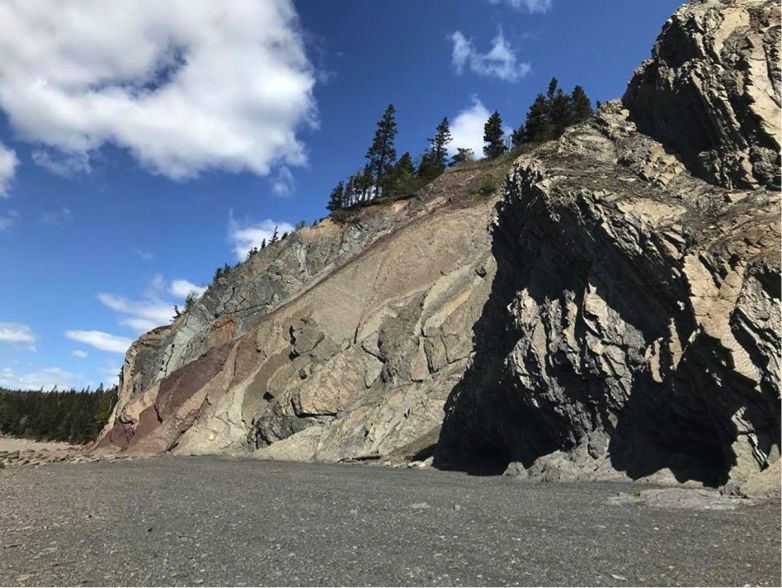
#ThoughtsOnRocks by Marlee Leslie
Let's talk about where to find some of Earth's most fascinating treasures – fossils. Finding a fossil is pretty special; holding a dinosaur bone or an ancient fern that is *hundreds of millions* of years old sure puts things in perspective. Not to boast (okay, we’re boasting a little bit) but Nova Scotia has some of the most amazing fossils in the world. While we are all at home seated on our couches, dreaming of the places we’ll go when restrictions are lifted, this quick overview of a few of the most common fossil localities in Cumberland County will help you plan. We’ll walk through how to access these locations, and what one can expect to discover at each spot.
An important note before we begin:
Fossils are like time capsules of data about the Earth’s history. They can tell us about the conditions on the planet millions of years ago, the creatures that called it home, and show linkages between different lifeforms, past and present. Because of this, fossils are deserving of unique protections to ensure researchers have continued access to crucial insights about the Earth's past. In Nova Scotia, they can only be collected by someone with a special permit called a Heritage Research Permit.
“Why bother searching”, you ask, “if I can't dig out and drag home a dinosaur bone of my own?” Yes, I know – it would look great as a companion to your garden gnome. But we all have an important role to play in unlocking Earth’s mysteries. Many of Nova Scotia's most amazing fossil finds have been discovered by folks out for a peaceful beach walk, or by hobbyists with a trained eye! If you find a fossil, leave it where it is, take a picture, and then contact us at the Fundy Geological Museum (or a local natural history museum if outside Nova Scotia) - we'll be so grateful! Finding and reporting fossils is one of the most important tasks of citizen scientists and a valuable way for you to help your local Museums!
Okay, let’s look at three key sites in Cumberland County… but first a safety warning!
All three sites listed below are beach cliffs and therefore provide a significant safety risk. Do not approach within 20 meters of a cliff without a hardhat. Do not travel to these sites without telling someone (not with you) where you are going and when you expect to return. Do not disturb the cliffs in any way aka no digging for fossils, it is illegal and dangerous!
Wasson Bluff
Note that beach walks are not currently permitted under public health guidelines.
In Parrsboro, take a left from Main Street onto Two Islands Road (the same road the Fundy Geological Museum is on), continue driving straight past the museum for about 15 minutes - you'll see a sign for Wasson Bluff on your right. The trail down to the beach is short but steep with loose gravel, so be cautious and take it slow. No need to show off – the seagulls aren’t judging!
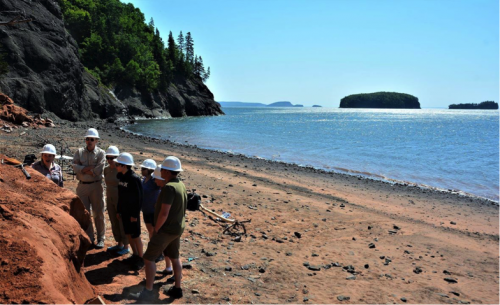
Take an Instagram-worthy photo and wonder at the trove of fossils at Wasson Bluff.
Ah, Wasson Bluff. Not just a beautiful view (bring your camera!), it’s also home to the oldest-known dinosaur bones in Canada and one of the richest Jurassic fossil beds ever discovered in North America. The Fundy Geological Museum maintains a research site here year-round and regularly monitors the cliffs for specimens unearthed by the tides. These 200-million-year-old cliffs reveal the bones of dinosaurs and mammal-like reptiles, ancient crocodilians, and many other specimens. It’s hard to closely examine the sandstone without spotting some type of bone. This is an excellent spot to spend an afternoon on a behind-the-scenes tour with a Fundy Geological Museum expert.

“Look, money! And in front of that, a tiny fossilized jawbone unearthed at Wasson Bluff."
East Bay
From Ottawa House Museum, walk towards the right side of Partridge Island. When you have almost reached the island, turn right and walk along the beach. It is rocky underfoot, so expect a moderately difficult walk and always be careful to keep your distance from the cliffs to avoid falling rocks.
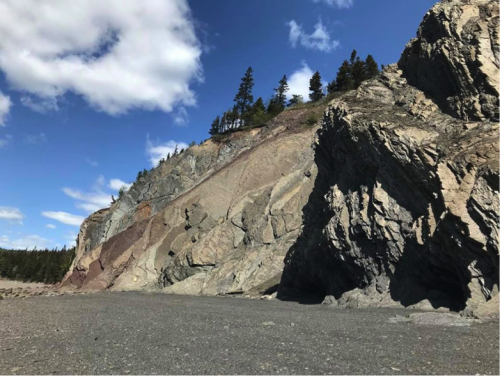
Check out the flat rock of the cliffs at East Bay for footprints, trackways, and ripples!
Not far from the Museum is another exciting fossil site, and another place where the museum offers guided tours. East Bay takes you back 300 million years ago into the lives of early amphibians and creatures like horseshoe crabs that have left behind traces in the cliff-face. Looking up, way up, one can spot these well-preserved footprints and trackways. Looking down, a careful inspection of the rocks below your feet can reveal small fossils in the shale that look like clamshells. Also, be on the lookout for wave rippling in the stone.
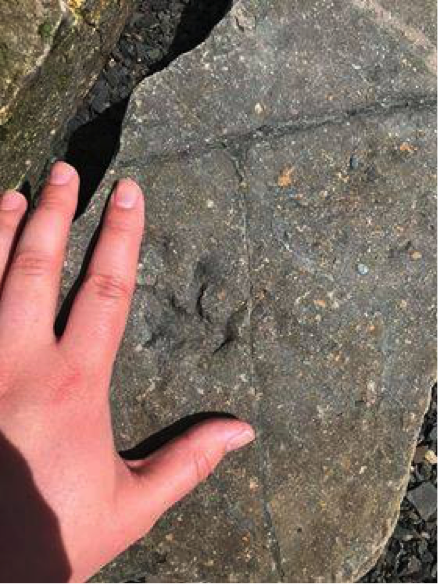
An East Bay footprint.
Joggins
The Joggins Fossil Institute is located at 100 Main Street in the community of Joggins. During the summer season, the beach at Joggins is accessible via stairs. Though the beaches and cliffs are not accessible by wheelchair, the Joggins Fossil Institute, which holds a stunning collection of fossils, is fully accessible. Stay tuned to their website for opening timelines and protocols!
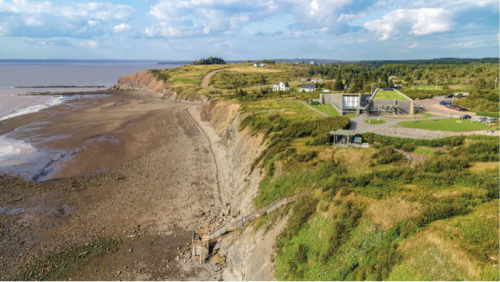
The Joggins Fossil Institute, resting above the famed fossil cliffs and beach.
Sometimes, even the pros can search for a whole day without finding a single fossil. Never fear! You are guaranteed to spot one at Joggins’ fossil cliffs. 100 million years older than the Wasson Bluff site and the fossils found there, one can discover a multitude of well-preserved plant and animal fossils at Joggins: fossilized reptiles, tree stumps, even a Calamites stem – a large tree related to present-day horsetails. The cliffs at Joggins house pristine examples of life in the Coal Age and demonstrate a key point in the evolution of life: the time period when living things emerged from water and started living on land. Visitors are welcome to explore on their own if the stairs are in place for the season, or they can join a fantastic guided tour.
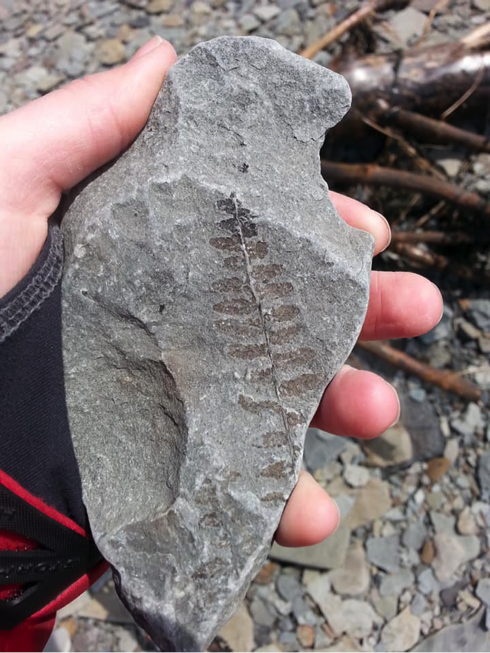
A fern fossil from Joggins.
We hope you have a great time when it’s safe to start exploring again!
Visit the Fundy Geological Museum to explore the world’s highest tides, Canada’s oldest dinosaurs, & the gorgeous minerals of Nova Scotia! Check out our Facebook, Twitter, & Instagram accounts for behind-the-scenes looks at all the things!
About the author
Marlee Leslie is Fundy Geological Museum’s Marketing Coordinator. Her studies took her from Canada’s east coast to the west coast, and back again. She is passionate about local food and regenerative agriculture, her rural Nova Scotian community, and can usually be found on a horse or behind a camera.